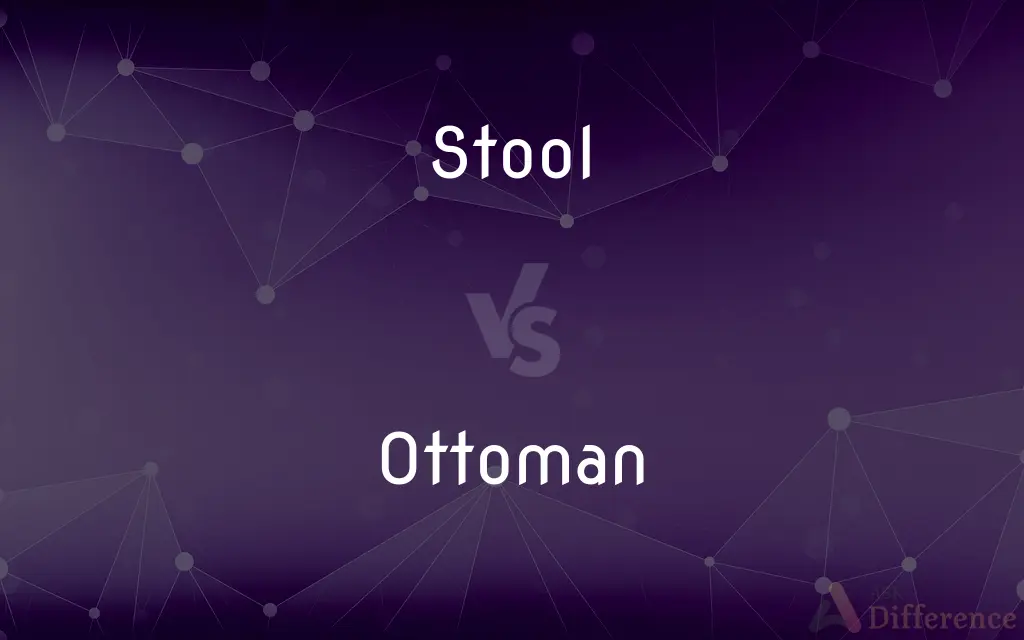Stool vs. Ottoman — What's the Difference?
By Tayyaba Rehman & Maham Liaqat — Updated on April 27, 2024
A stool is a seat without a back or arms, typically for one person; an ottoman is a padded, upholstered seat without a back, often used as a footrest.

Difference Between Stool and Ottoman
Table of Contents
ADVERTISEMENT
Key Differences
A stool is typically a simple form of seat designed for one person, characterized by its lack of back and arms. It is often used in bars, kitchens, or workplaces where space is limited and mobility around the seat is needed. On the other hand, an ottoman is an upholstered, cushioned piece of furniture that also lacks a back but is primarily used as a footrest or additional seating. Ottomans are often part of a living room set and can serve as storage if they come with a hollow interior.
Stools are usually made from materials such as wood, metal, or plastic, which make them sturdy and easy to clean. This makes them suitable for both public and private environments where quick, informal seating is required. Whereas, ottomans are typically upholstered with fabric, leather, or velvet, contributing to their aesthetic appeal and comfort. This upholstery also makes them less suited for environments where cleanliness and durability are paramount.
The height of stools can vary, but many are designed to match the height of counters or bars. They often feature a footrest to aid in comfort, especially given their lack of back support. In contrast, ottomans are generally lower to the ground, designed to align with the height of other living room furniture such as sofas and chairs, making them ideal for lounging.
Stools are more utilitarian in design and function, primarily used for seating. They are common in settings like bars, kitchens, or artist studios. Ottomans, on the other hand, can double as storage units (often referred to as storage ottomans), providing a place to stow items like magazines, throws, or toys, enhancing their functionality in a living space.
In terms of mobility, stools are often lightweight and easily moved, which is beneficial in commercial settings or homes where flexible arrangements are needed. Conversely, ottomans can be heavier, especially those designed for storage or larger upholstered ones, which may limit their ease of movement but increase their versatility as permanent fixtures in a room.
ADVERTISEMENT
Comparison Chart
Definition
A seat without back or arms
Upholstered seat without back, often a footrest
Primary Use
Seating for bars, kitchens
Footrest, additional seating in living rooms
Construction
Made from wood, metal, or plastic
Often upholstered with fabric or leather
Functionality
Simple seating
Can include storage, enhances decor
Mobility
Lightweight and portable
Heavier, sometimes less portable
Compare with Definitions
Stool
Used for seating in settings where space is at a premium.
She pulled up a stool to the crowded bar.
Ottoman
Used as a footrest or extra seating.
The children sat on the ottoman during the family game night.
Stool
Can vary in height but often includes a footrest.
The tall stool at the piano bar had a circular footrest.
Ottoman
Can be upholstered in various textiles.
Their velvet ottoman added a touch of luxury to the living room.
Stool
A seat without back or arms.
He grabbed a stool to reach the high shelf.
Ottoman
Often part of a living room furniture set.
The ottoman matched the pattern and color of the sectional sofa.
Stool
Typically designed for one person.
Each kitchen counter stool was spaced evenly along the bar.
Ottoman
May feature storage space inside.
They stored their board games inside the storage ottoman.
Stool
Often made of durable materials like wood or metal.
The artist sat on a metal stool while painting.
Ottoman
A padded, upholstered seat without a back.
She propped her feet up on the plush ottoman after a long day.
Stool
A backless and armless single seat supported on legs or a pedestal.
Ottoman
A Turk, especially a member of the family or tribe of Osman I.
Stool
A low bench or support for the feet or knees in sitting or kneeling, as a footrest.
Ottoman
An upholstered sofa or divan without arms or a back.
Stool
A toilet seat; a commode.
Ottoman
An upholstered low seat or cushioned footstool.
Stool
Evacuated fecal matter.
Ottoman
A heavy silk or rayon fabric with a corded texture, usually used for coats and trimmings.
Stool
A stump or rootstock that produces shoots or suckers.
Ottoman
Of or relating to the Ottoman Empire or its people, language, or culture.
Stool
A shoot or growth from such a stump or rootstock.
Ottoman
Turkish.
Stool
(Botany) To send up shoots or suckers.
Ottoman
(furniture) An upholstered sofa, without arms or a back, sometimes with a compartment for storing linen etc.
Stool
To evacuate the bowels; defecate.
Ottoman
(furniture) A low stool or thick cushion used to rest the feet or as a seat.
Stool
(Slang) To act as a stool pigeon.
Ottoman
(textiles) A fabric with a pronounced ribbed or corded effect, often made of silk or a mixture of cotton and silk-like yarns.
Stool
A seat, especially for one person and without armrests.
Ottoman
Of or pertaining to the Turks; as, the Ottoman power or empire.
Stool
A seat for one person without a back or armrests.
Ottoman
A Turk.
Stool
A footstool.
Ottoman
A stuffed seat without a back, originally used in Turkey.
Stool
A seat with a back; a chair.
Ottoman
A Turk (especially a Turk who is a member of the tribe of Osman I)
Stool
A throne.
Ottoman
The Turkish dynasty that ruled the Ottoman Empire from the 13th century to its dissolution after World War I
Stool
(obsolete) A close-stool; a seat used for urination and defecation: a chamber pot, commode, outhouse seat, or toilet.
Ottoman
Thick cushion used as a seat
Stool
(horticulture) A plant that has been cut down until its main stem is close to the ground, resembling a stool, to promote new growth.
Ottoman
A low stool to rest the feet of a seated person
Stool
Feces, excrement.
I provided the doctor with stool samples.
Ottoman
Of or relating to the Ottoman Empire or its people or its culture
Stool
A production of feces or excrement, an act of defecation, stooling.
Stool
(archaic) A decoy; a portable piece of wood to which a pigeon is fastened to lure wild birds.
Stool
(nautical) A small channel on the side of a vessel, for the deadeyes of the backstays.
Stool
Material, such as oyster shells, spread on the sea bottom for oyster spat to adhere to.
Stool
A plant from which layers are propagated by bending its branches into the soil.
Stool
To produce stool: to defecate.
Stool
(horticulture) To cut down (a plant) until its main stem is close to the ground, resembling a stool, to promote new growth.
Stool
(agriculture) To ramify; to tiller, as grain; to shoot out suckers.
Stool
A plant from which layers are propagated by bending its branches into the soil.
Stool
A single seat with three or four legs and without a back, made in various forms for various uses.
Stool
A seat used in evacuating the bowels; hence, an evacuation; a discharge from the bowels.
Stool
A stool pigeon, or decoy bird.
Stool
A small channel on the side of a vessel, for the dead-eyes of the backstays.
Stool
A bishop's seat or see; a bishop-stool.
Stool
A bench or form for resting the feet or the knees; a footstool; as, a kneeling stool.
Stool
Material, such as oyster shells, spread on the sea bottom for oyster spat to adhere to.
Stool
To ramfy; to tiller, as grain; to shoot out suckers.
Stool
A simple seat without a back or arms
Stool
Solid excretory product evacuated from the bowels
Stool
(forestry) the stump of a tree that has been felled or headed for the production of saplings
Stool
A plumbing fixture for defecation and urination
Stool
Lure with a stool, as of wild fowl
Stool
React to a decoy, of wildfowl
Stool
Grow shoots in the form of stools or tillers
Stool
Have a bowel movement;
The dog had made in the flower beds
Common Curiosities
Do ottomans come in different shapes?
Yes, ottomans are available in various shapes including square, rectangular, round, and even more unique forms to suit different decor styles.
What are the typical materials used in making a stool?
Stools are usually made from sturdy materials such as wood, metal, or plastic.
Why are stools commonly used in bars?
Stools are ideal for bars due to their height and the minimal space they occupy, facilitating easy access to the bar counter.
Can stools be adjustable in height?
Yes, many modern stools are designed with adjustable heights, usually through a pneumatic lever, making them versatile for various settings.
Can an ottoman be used for seating?
Yes, ottomans can be used for extra seating in addition to being a footrest.
What styles of stools are most popular?
Popular styles include bar stools, counter stools, and saddle stools, each offering different aesthetic and functional benefits.
What makes an ottoman different from a regular chair?
Unlike chairs, ottomans are usually lower to the ground, lack a back, and are often used as a footrest.
How do you clean and maintain an ottoman?
Cleaning an ottoman depends on the upholstery, but typically involves vacuuming, spot cleaning with appropriate cleaners, and avoiding exposure to direct sunlight to prevent fading.
What should be considered when choosing an ottoman for a living room?
Consider the ottoman's size, style, color, material, and whether additional features like storage are needed to complement the living room's decor and functionality.
Is there a difference in the durability between stools and ottomans?
Stools tend to be more durable due to their materials like wood and metal, making them suitable for high-traffic areas, whereas ottomans may require more maintenance due to their upholstery.
Are ottomans suitable for outdoor use?
Generally, ottomans are not designed for outdoor use unless specifically made with weather-resistant materials and upholstery.
How can an ottoman enhance home decor?
Ottomans add both functional and aesthetic value, serving as footrests, extra seating, and visual interest through their varied designs and materials.
Can the design of a stool affect its comfort?
Yes, design elements like footrests, seat padding, and material can significantly influence the comfort level of a stool.
Are there eco-friendly options for stools and ottomans?
Eco-friendly options are available for both stools and ottomans, utilizing sustainable materials and production processes.
Share Your Discovery

Previous Comparison
Chamomile vs. Camomile
Next Comparison
Repose vs. RestAuthor Spotlight
Written by
Tayyaba RehmanTayyaba Rehman is a distinguished writer, currently serving as a primary contributor to askdifference.com. As a researcher in semantics and etymology, Tayyaba's passion for the complexity of languages and their distinctions has found a perfect home on the platform. Tayyaba delves into the intricacies of language, distinguishing between commonly confused words and phrases, thereby providing clarity for readers worldwide.
Co-written by
Maham Liaqat













































